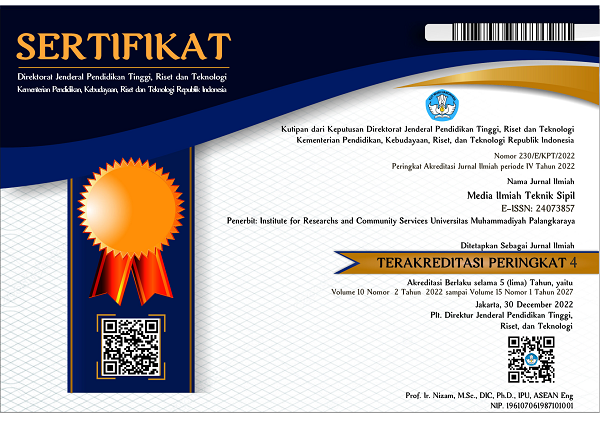Kelayakan Abu Terbang PLTU Buntoi Sebagai Campuran Beton Geopolimer
Feasibility Of Flying Ash Of PLTU Buntoi As A Geopolimary Concrete Mixture
DOI:
https://doi.org/10.33084/mits.v9i2.2063Keywords:
Abu Terbang, Beton Geopolimer, Geopolimer, NaOH, Na2SiO3Abstract
The main basic ingredients needed for the manufacture of this geopolymer material are materials that contain a lot of silica and aluminia elements. The 1st stage test was carried out to determine the geopolymer paste with the maximum compressive strength at the ratio of NaOH to Na2SiO3 of 1; 1.5; 2; 2.5. The second stage of testing was carried out using a geopolymer paste with the highest compressive strength, namely the ratio of NaOH to Na2SiO3 of 2.5 with a compressive strength of 22.56 MPa. Based on the results of the compressive strength test, the maximum compressive strength at the age of 28 days is 7.64 MPa. The results of the compressive strength of concrete are much lower than the compressive strength of the paste, it shows that the paste does not bind too much with the aggregate. This is evidenced by the results of the compressive strength of conventional concrete which is much higher than that of geopolymer concrete using the same aggregate. With the results of the maximum compressive strength at the age of 28 days is 29.51 MPa.
Downloads
References
Davidovits, J., (1970), Beton Geopolimer. Prancis.
Davidovits, J., (2012), Aplikasi Geopolimer Berdasarkan Rasio Si/Al. Prancis.
Ekaputri J.J. & Triwulan, (2013), Sodium Sebagai Aktivator Fly Ash, Trass dan Lumpur Sidoarjo Dalam Beton Geopolimer. Fakultas Teknik Institut Teknologi Sepuluh Nopember.
Ferdy., (2010), Pengaruh Temperatur Dan Waktu Curing Terhadap Kuat Tekan Pasta Geopolimer Berbahan Dasar Abu Terbang. Fakultas Teknik Universitas Indonesia.
Liliana, S, & Meilawaty, O, (2018), Komposisi Kimia Fly Ash PLTU Buntoi Kabupaten Pulang Pisau. Palangka Raya.
Meilawaty, O., (2017), Buku Panduan Panduan Praktikum Beton. Fakultas Teknik Universitas Palangka Raya.
Mulyono, T., (2004), Teknologi Beton. Yogyakarta.
Septia, P., (2011), Studi Literatur Pengaruh Konsentrasi NaOH dan Rasio NaOH:Na2SO3, Rasio Air/Prekusor, Suhu Curing dan Jenis Prekursor Terhadap Kuat Tekan Beton Geopolimer. Fakultas Teknik Universitas Indonesia.
Sumajouw dan Dapas, (2012), Penggunaan Sodium Hidroksida dan Sidium Silikat. Manado.
Sukirman, S., (2003), Pengertian Agregat. Palembang.
Tion, F., (2019), Pemanfaatan Abu Batu Bara Sebagai Bahan Campuran Beton Pada Konstruksi Bangunan. Fakultas Teknik Universitas Palangka Raya.
Windah, Sumajouw, & Manuahe, (2014), Kuat Tekan Beton Geopolymer Berbahan Dasar Abu Terbang (Fly Ash), Fakultas Teknik Universitas Sam Ratulangi.
Winter & George, (1993), Material Penyusun Semen. Inggris.
Yuanda, Fadli, & Drastinawati, (2015), Pemanfaatan Limbah Abu Terbang (Fly Ash) Sebagai Bahan Pembuatan Beton Geopolimer. Fakultas Teknik Universitas Riau.
Downloads
Published
How to Cite
Issue
Section
License
All rights reserved. This publication may be reproduced, stored in a retrieval system, or transmitted in any form or by any means, electronic, mechanical, photocopying, recording.







